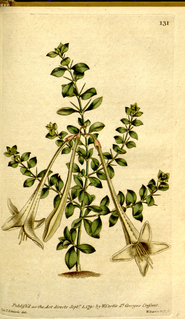
Nashia is a genus of flowering plant in the vervain family, Verbenaceae.

Plumeria is a genus of flowering plants in the dogbane family, Apocynaceae. Most species are deciduous shrubs or small trees. The species variously are indigenous to Mexico, Central America and the Caribbean, and as far south as Brazil and north as Florida, but are grown as cosmopolitan ornamentals in warm regions. Common names for plants in the genus vary widely according to region, variety, and whim, but Frangipani or variations on that theme are the most common. Plumeria also is used directly as a common name, especially in horticultural circles.
Lasiocroton is a plant genus of the family Euphorbiaceae first described as a genus in 1859. The genus is endemic to the West Indies.
- Lasiocroton bahamensisPax & K.Hoffm. - Bahamas, Cuba, Haiti
- Lasiocroton fawcettiiUrb. - Jamaica
- Lasiocroton gracilisBritton & P.Wilson - SE Cuba
- Lasiocroton gutierreziiJestrow - Cuba
- Lasiocroton harrisiiBritton - Jamaica
- Lasiocroton macrophyllus(Sw.) Griseb. - Jamaica
- Lasiocroton microphyllus(A.Rich.) Jestrow - Cuba
- moved to other genera (Bernardia Croton Leucocroton)
- Lasiocroton cordifoliusBritton & P.Wilson - Leucocroton cordifolius (Britton & P.Wilson) Alain
- Lasiocroton prunifoliusGriseb. - Croton punctatusJacq.
- Lasiocroton subpeltatusUrb. - Leucocroton subpeltatus(Urb.) Alain
- Lasiocroton trelawniensisC.D.Adams - Bernardia trelawniensis(C.D.Adams) Jestrow & Proctor

Chaetocarpus is a plant genus of the family Peraceae, formerly Euphorbiaceae, first described as a genus in 1854. Chaetocarpus species are trees or shrubs. There native to the Americas, Africa, and Asia. Some species are endangered.
- Chaetocarpus acutifolius(Britton & P.Wilson) Borhidi - Sierra de Moa in Cuba
- Chaetocarpus africanusPax - C Africa
- Chaetocarpus castanocarpus(Roxb.) Thwaites - SE Asia, Yunnan, Assam, Bangladesh, Sri Lanka
- Chaetocarpus cordifolius(Urb.) Borhidi - Cuba, Hispaniola, Jamaica
- Chaetocarpus coriaceusThwaites - Sri Lanka
- Chaetocarpus cubensisFawc. & Rendle - Cuba
- Chaetocarpus echinocarpus (Baill.) Ducke - Bolivia, Brazil
- Chaetocarpus ferrugineusPhilcox - Sri Lanka
- Chaetocarpus gabonensisBreteler - Gabon
- Chaetocarpus globosus(Sw.) Fawc. & Rendle - Jamaica, Cuba, Dominican Rep.
- Chaetocarpus myrsinitesBaill. - Bolivia, Brazil
- Chaetocarpus parvifoliusBorhidi - Cuba
- Chaetocarpus pearceiRusby - Bolivia
- Chaetocarpus pubescens(Thwaites) Hook.f. - Sri Lanka
- Chaetocarpus rabarabaCapuron - Madagascar
- Chaetocarpus schomburgkianus(Kuntze) Pax & K.Hoffm. - Colombia, Venezuela, 3 Guianas, NW Brazil

Calyptranthes is a genus of flowering plants in the family Myrtaceae. They are known commonly as lidflowers, spicewoods, and mountainbays. There are about 100 species.

Pimenta is a genus of flowering plants in the myrtle family, Myrtaceae described as a genus in 1821. It is native to Central and South America, Mexico, and the West Indies.
Auerodendron is a genus of plant in family Rhamnaceae.

Casasia is a genus of flowering plants in the family Rubiaceae. These shrubs or small trees occur on the Caribbean islands and in one case in Florida. Some of the ten accepted species were formerly placed elsewhere, e.g. in the related genip-tree genus (Genipa), in Gardenia or in Randia.
Exostema is a genus of flowering plants in the family Rubiaceae. It consists of trees and shrubs, endemic to the neotropics, with most of the species occurring in the West Indies.

Harpalyce is a genus of flowering plants in the legume family, Fabaceae. It belongs to the subfamily Faboideae.
Gundlachia, commonly called Goldenshrub, is a genus of flowering plants in the daisy family.
Heptanthus is a genus of Cuban flowering plants in the sunflower family.
Lantanopsis is a genus of Caribbean flowering plants in the sunflower family.

Chaptalia is a genus of flowering plants in the daisy family.

Catesbaea is a genus of flowering plants in the Rubiaceae family. It occurs in the West Indies, The Bahamas, and the Florida Keys. The genus is named in honour of English naturalist Mark Catesby.

Callicarpa (beautyberry) is a genus of shrubs and small trees in the family Lamiaceae. They are native to east and southeast Asia, Australia, Madagascar, southeast North America and South America.
Pseudocarpidium is a genus of flowering plants in the family Lamiaceae first described in 1906. It is native the West Indies.
- Pseudocarpidium avicennioides(A.Rich.) Millsp. - eastern Cuba
- Pseudocarpidium domingense(Urb. & Ekman) Moldenke - Hispaniola
- Pseudocarpidium ilicifolium (A.Rich.) Millsp. - Cuba
- Pseudocarpidium multidens(Urb.) Moldenke - eastern Cuba
- Pseudocarpidium neglectaBisse - Cuba
- Pseudocarpidium pungensBritton - eastern Cuba
- Pseudocarpidium rigens(Griseb.) Britton - eastern Cuba
- Pseudocarpidium shaferiBritton - eastern Cuba
- Pseudocarpidium wrightiiMillsp. - Bahamas, Cuba

Heterosavia is a genus of the family Phyllanthaceae first described as a genus in 2008. It is native to the West Indies and southern Florida.
- Heterosavia bahamensis(Britton) Petra Hoffm. - Monroe County in Florida, Bahamas, Cuba, Jamaica, Cayman Islands, Turks & Caicos, islands of southwest Caribbean
- Heterosavia erythroxyloides' (Griseb.) Petra Hoffm. - Cuba, Hispaniola
- Heterosavia laurifolia' (Griseb.) Petra Hoffm. - Cuba
- Heterosavia maculata(Urb.) Petra Hoffm. - Cuba

Mitracarpus is a plant genus in the coffee family Rubiaceae. Girdlepod is a common name for some species in this genus.

Guilandina is a genus of flowering plants in the legume family, Fabaceae. It belongs to the subfamily Caesalpinioideae and tribe Caesalpinieae.














